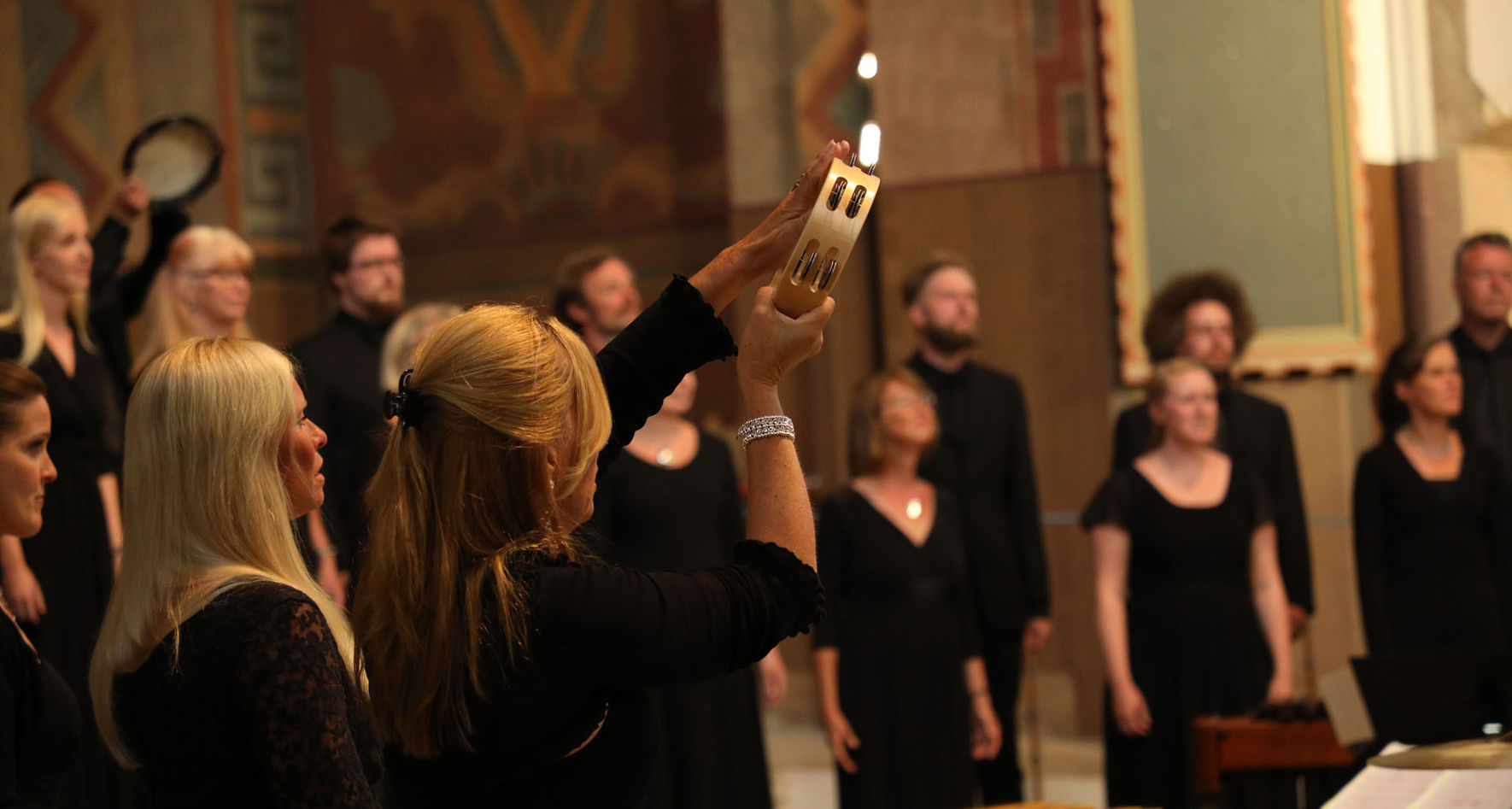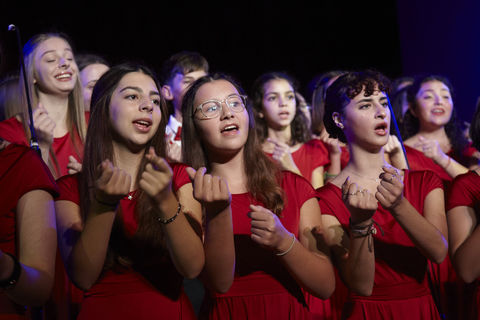
“We need to find ways of combining tradition with development”
Swedish conductor Susanna Lindmark about choral singing in Sweden, her choir project Arctic Light and her piece “Song of Hope”
Choir-singing has played an important role in shaping the Swedish society and still today choral activities help building bridges between people. There’s an estimated 600,000 people all over Sweden singing in a choir, which is around 17% of the population. And Swedish choral culture is very successful, even and especially internationally: From professional vocal ensembles like The Real Group to traditional choral ensembles with great tradition like Lunds Studentsångförening or the choirs of Adolf Fredrik's Music School – Swedish choirs and vocal ensembles have an excellent reputation in the international choral scene and many of the Swedish choirs and vocal ensembles are outstandingly successful in international choir competitions around the world.
But what is their secret of success? What makes Swedish choir music and Swedish choir traditional so special? Swedish choir conductor Susanna Lindmark has tried to give us some answers.
Choral Singing is popular in Sweden. What is it that fascinates Swedish people in that pastime?
I find it difficult to give an overall answer to this question since it has many layers, but I think recent research made during the Covid pandemic period by professor Ewa Bojner Horwitz (in collaboration with choral associations in Sweden and Norway) can show some of the reasons why people want to sing in a choir. In her study she asked choir singers from Sweden and Norway what they missed most with singing in a choir, when all choir rehearsal activities were shut down, and the answers were (very shortly): the social factor - the feeling of togetherness, emotional and artistic expression and being in a creative flow together.
My own experiences of leading a lot of different choirs on different levels of difficulty regarding the musical material can absolutely agree to the results in the study.
As singers we carry our instrument inside – and the fact that everybody has a voice makes us equals in a sense. Singing together means sharing emotions and expressions and builds a community where even our hearts beat in the same rhythm. Choral singing has engaged a great amount of people in Sweden during a long time, but with the Covid-19 pandemic everything changed very fast, and I think that there is some re-building choral work to do now, as life is going back to be more like before the pandemic. To be able to support the choral life after the pandemic in Norrbotten, where I live, I last year took the initiative to build a regional Choral Centre called Körcentrum Nord, and this feels really important!
We have now started officially as a three-year project with funding from both the Swedish Cultural Council and the Regional Council in Norrbotten, together with the Regional Institution of Music, Norrbottensmusiken, where I am employed to lead the work.
There are many choirs from Scandinavia and especially from Sweden, which are famous and successful all around the world. What is the secret of the Swedish way to success?
That is a good question. I wish I could point out a secret ingredient, but of course many factors play a role here. There are some really good choirs in Sweden, and my experience is that we share that with many countries all over the world, and it is fantastic how many different colors and characters all these choirs all over the world have regarding to sound, expression and repertoire. Since singing is very deeply connected to the human being. This makes also our language, cultural and musical traditions and folklore natural brick stones in the building of a choral sound, and that can maybe partly explain that different parts of the world carry different choral sound ideals. But since our world is an open place we also, luckily enough we have the opportunity to be inspired in a million ways from a lot of choral expressions and traditions.
I think that one part of Scandinavian choir’s good reputation has to do with the choral sound ideal. If I should describe how I interpret that sound ideal I should say that it is lyrical, well-balanced, clear, well- intonated and rich on overtones and often without vibrato. But of course, there are as many choir sounds as there are choirs and the matter of beauty lie in the ear of the listener. Other factors for any successful choir I believe is the choice of repertoire and the ability to express the music in a way that invites and includes the listener in the audience. For me personally, both as a conductor, composer and listener it is important that the musical expression has an emotional engagement together with the sound qualities above, and of course rhythmical clarity and fidelity to the score.
Eric Ericson, who passed away in 2013, is usually the first name that comes to one’s mind when thinking and learning about Swedish choral music. After his death, how did the Swedish choral scene change and how much influence does his legacy still have on the generation of young choir directors nowadays?
I think that Eric Ericson’s role as “Father of the choral miracle” in Sweden is solid and clear, and after him there also have been, are and will be several great choral conductors to carry his legacy of deep musical and choral related knowledge forward.
However, I think that our society now is looking quite different from what it was during Ericsons time regarding a lot of things, for example the role of choir singing in schools with children, that has changed a lot with for example fewer school choirs. It is really important that we who work in the choral sphere engage in getting children to sing, so that we don´t lose a whole generation of young people, growing up without knowing the richness of owning a voice and the power of singing together. Of course, for musical purposes, but also for individual personal growth, health and as an important part of building sustainable empathic societies and good leaders in the future.
Along with this, carrying the rich knowledge that our choral traditions hold when new generations of conductors rise, I think that is of great importance also to embrace a renewal of ways of expression regarding the art of choral performances. As our society changes and new generations of choral singers grow up with maybe other frames of musical references we need to find ways of combining tradition with development to continue building a strong choral life. In my opinion it should never be a matter of either tradition or new ideas, but always a combination, like to sides of a coin, to develop choral music.
I also think that it is important to set eyes on the matters of leadership and innovative new methods, besides the general traditional platform of choral knowledge such as of repertoire, interpretation, choral sound and voice treatment etc. My experience is that working in co-creative ways with choirs, including the choir as a creative resource, are important parts in the ongoing work of development of choir as a unique artistic expression. And also, to attract new singers and conductors.
What is the mission behind your choral project Arctic Light? How does it line up or perhaps break with Swedish choral traditions?
My mission with Arctic Light when I founded the choir in 2004, was to create a musical greenhouse of high artistic level and strong regional identity for young female singers in Norrbotten in the northern part of Sweden. Our region is an industrial region of mining, wood and steel, situated far from the big city areas, holding large distances and a low population and great wilderness nature experiences. Our region at the Polar circle area also had very little girls choir tradition meaning young female singers was a very invisible group. Due to our large distances with the singers living in different cities, and Arctic Light Choir meet for rehearsals only a couple of times a year. Some girls travel more than 400 km to every rehearsal very few travels less than 50 km. My vision was to create a creative choral environment where ever singer is allowed to contribute with both voice, mind, body and creative ideas and of high importance, an emotional expression. To build a vocal sound and to be able to reach as high artistic level as possible in very little time, it has been necessary for me as a conductor to mould out methods that suits our quite untraditional rehearsal structure and to create a safe environment where every singer are among friends and dare to go outside your comfort zone, so that every individual should find her own place and space in the group and to be able to be at her best without pressure and prestige. To do that I use different kinds of improvisation, work with emotional expression and a have certain way of building the choir sound.
I think that my work with Arctic Light can be characterized as non-traditional, but I think it aligns with tradition as a platform on which we solidly stand. This platform gives the opportunity to explore new musical worlds and expressions. As a composer also, my aim to create a regional identity of sound and expression with Arctic Light, has resulted in new music, compositions for young choirs with for example inspiration from the great mountain areas, Nordic lights, and different cultural heritages in our region such as expressions from the sami culture. For me again it is never about either tradition or renewal. To align with the question of factors for success, I would say that building a strong artistic musical identity built on authentic values is a factor that has great possibilities for leading to great development both for the choir and the individual.
Many choirs around the world are facing problems in recruiting new talents and young singers. How do you motivate the young generation to sing?
This is a challenge in our time. Everyone is so occupied with so many things.
However, my experience tells me that if you have a strong authentic vision that connects with the singers themselves, it is more likely that they will engage. By including the singers and create a friendly atmosphere where creative processes and exploring and learning, rather than delivering a result, are the focus points. (The good results will come anyway) By finding high quality repertoire (regardless of difficulty) that will connect with the singers where they are, and also be very thorough with the level of difficulty of the music, so that there will be challenge enough but not too much. I find that rhythmical music with a touch of folk music often is very effective and that young singers often can relate very well to quite difficult rhythms.
But most of all I believe in a leadership where every individual in the choir is of equal worth, is allowed to try and fail and grow and to take active part in the creative process.
Your choral work “Song of Hope” is performed by choirs from around the world. Did you use any typical elements of contemporary Swedish music for this piece and what are these?
Song of Hope is a special piece in that matter that the ideas behind it came to me on a flight to Indonesia and I wrote almost all of it down on a paper on that plane. Since then it really has continued flying out in the world and for that I am very grateful. When I write music, I am rather intuitive and it is not until the later stages of the composition process that I involve my theoretical brain, I aim to be in the creative flow catching the ideas, letting them speak. Of course, my knowledge of composing is the theoretical platform of knowledge without which I could not compose, but when I wrote it I just wanted to express what the lyrics communicated musically. I often let the text lead the process and always have an emotional engagement in my composition process. So, I don´t compose with the purpose of use certain elements, but of course there are elements used in every piece. I used folk music- based rhythmical elements to illustrate the character of the melody of hope in the part that could be associated with a Swedish traditional trall - a kind of ongoing musical joyful energy to lift us up.
You’ve probably been in touch with some choirs that performed “Song of Hope”. Can you mention few names and tell us about their comments and reactions to the piece?
I have had the great joy to experience a lot of choirs singing Song of Hope, on concerts festivals, making music videos, choreographies, Youtube recordings and so on. I know the song has been sung in almost all continents by fantastic young choirs and their wonderful conductors, and I am grateful for them singing and expressing my music. It is hard for me to mention anyone above someone else, and of course I have received their appreciation, but maybe it is better if you ask someone to speak with their own words than I should try to recapture their experiences of the piece, something that I find difficult.
What was your message behind “Song of Hope” when you composed it and how might it be different from today’s point of view, in a period where a war in Europe, climate change, a worldwide pandemic and economic problems are more present than ever before?
My message with Song of Hope is that we all have a choice to choose goodness, warmth, love, comfort in difficult situations that life bring. It is a prayer for light to shine in darkness and that each one of us actually are these lights, if we choose to be. Everyone has a special glow and is able to let his or her light shine in this crazy world. We all are the same – children of this earth no matter age, race, background, ethnicity, gender etc.
We can all be sources of light in the dark and make a change for someone else, and these last years that has brought many different kinds of crisis I feel that the theme of the song still is highly relevant. It is really important not to lose hope in dark times, but with the power of music let the light shine through.



